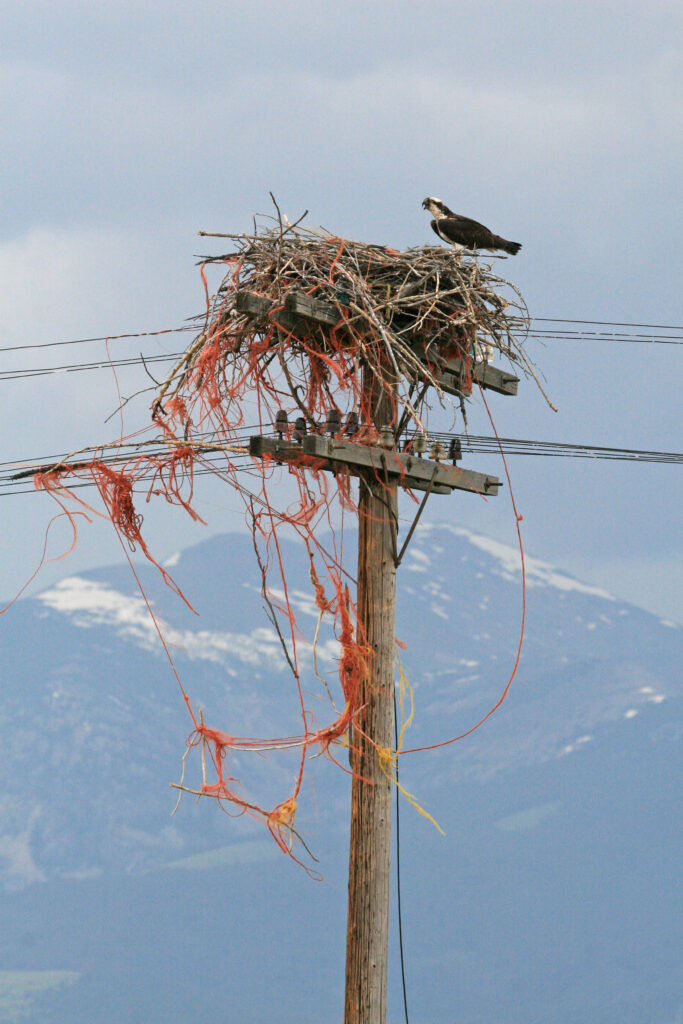"Baling" Montana's Osprey Out of Trouble: The Dangers of Baling Twine

As temperatures cool across Montana and we bid bon voyage to many of our feathered, warm-weather residents—we also say a temporary goodbye to a local icon. Western Montana’s Osprey begin departing for warmer climes in mid-September. By the time the leaves fly, these majestic birds should have arrived at (or at least be well on their way to) winter habitat in the southern US, Mexico, or Central America.
While they settle into their winter digs, we turn our attention from the wonders of fall migration to preparing our own homes for the long season ahead. We process vegetables, rake leaves, and put gardens to bed. But while we keep our focus on winter, there are also things we can do to prepare for the coming spring… and the return of our winged guests.
Likely, you have seen the large nests that Osprey create atop broken snags, telephone poles or human-made platforms. These impressive aeries, often constructed over generations, range in size from 2.5 to 6 feet across. And, they can be up to 13 feet deep! To build them, Osprey carefully construct woven stick bases, lined with bark, grasses, and lichen. This soft lining helps protect the eggs and chicks. Here, in Montana, there is another building material that—when available—appears irresistible to Osprey: baling twine. This strong, polypropylene cord is used for holding together bales of straw and hay. Superficially, the twine may seem a logical choice for nesting material. It is soft, pliable, and certainly holds together well. Unfortunately for Osprey, this seemingly ideal substance can turn out to be a lethal choice as a nesting material.
Baling twine’s fibrous structure snags on nesting material, winds its way around sticks, and catches just as easily on Osprey talons, legs, wings and necks. Entangled birds who try to free themselves can make matters worse, becoming ensnared, strangled, or unable to fly and then slowly starving to death. In addition to the adult birds killed this way, studies estimate that 10% of Osprey chicks die from entanglement in baling twine. And unfortunately, in our area, its use as a nesting material appears to be ubiquitous.
Project Osprey was founded by Rob Domenech, Director of Raptor View Research Institute, and is now co-led by Erick Greene, UM Professor Emeritus. It is a long-term study of osprey ecology in Montana’s upper Clark Fork River drainage. Although the project focuses on heavy metal contamination within the river basin, Project Osprey researchers have found baling twine in nearly every osprey nest they visit. When birds become entangled, provided they are discovered in time, Project Osprey researchers work with Brooke Tanner, Executive Director of Wild Skies Raptor Rehabilitation Center (WSRRC), to free the birds. Birds that are injured or too weakened to be released immediately are transported to WSRRC where they receive treatment. Although Tanner has witnessed a litany of heartbreaking events, fortunately she has also been a part of a number of successful rehabilitations.
Recently, Project Osprey and WSRRC responded to a call from a group of folks who were observing a family of Osprey on their nest when they noticed that one of the chicks had become entangled in baling twine. The researchers removed the injured chick from the nest and delivered it to WSRRC. The team then introduced another orphaned chick, newly rehabilitated by WSRRC, into the nest of the bereft Osprey parents, who quickly adopted the displaced youngster. Eventually the biological chick was also rehabilitated, and returned to the nest, where its parents and adopted sibling welcomed it home. To hear the full account of this remarkable story, watch Tanner Saul’s Wilder View on KPAX, Missoula’s local television station.

Photo: Erick Greene
As inspiring as the story above may be, with a little forethought and effort, it could have easily been avoided. Here are some things that you can do to help:
This fall, if you have hay fields, look behind you as you are baling. Pick up any trailing strands of twine that have been left behind. When loading and transporting hay and straw bales, check that the twine is secured and won’t not fall off or blow out of trucks and trailers.
If you use baled hay and straw for livestock, be sure to dispose of, or recycle, baling twine appropriately. Store loose twine in closed containers, or inside buildings, out of sight and out of reach of birds of prey.
While you’re out hiking or hunting this fall and winter, keep an eye out for loose baling twine. If you see some, gather it up and pack it out with you.
Check out the Owl Research Institute for a number of baling twine-specific recycling programs that may be able to help you with disposal.
